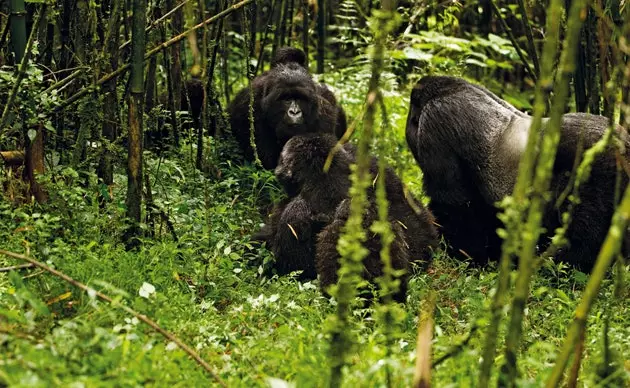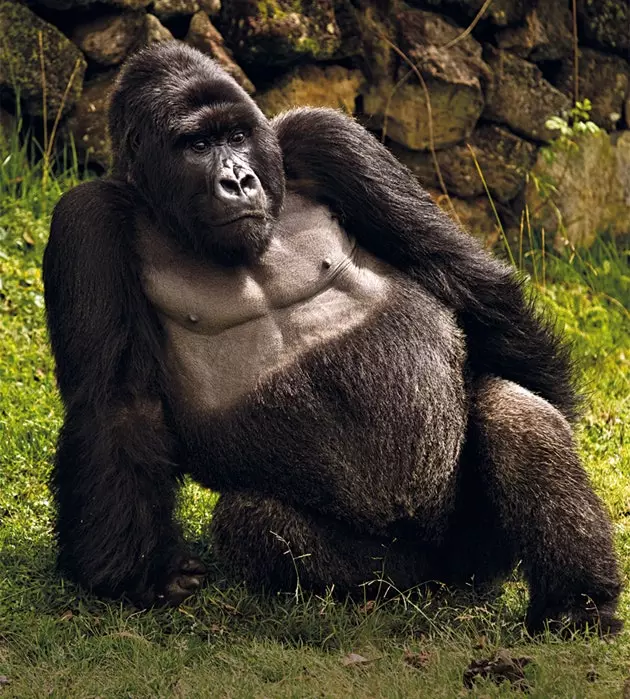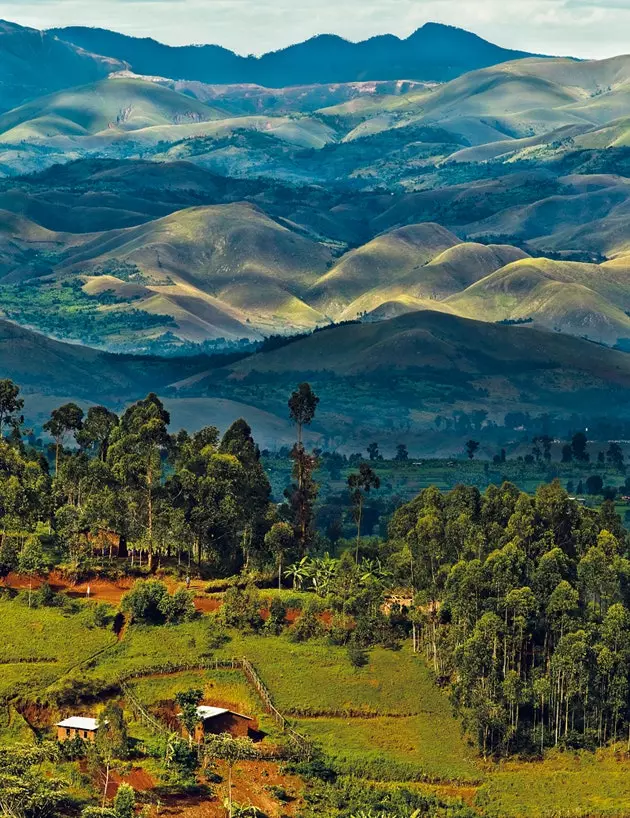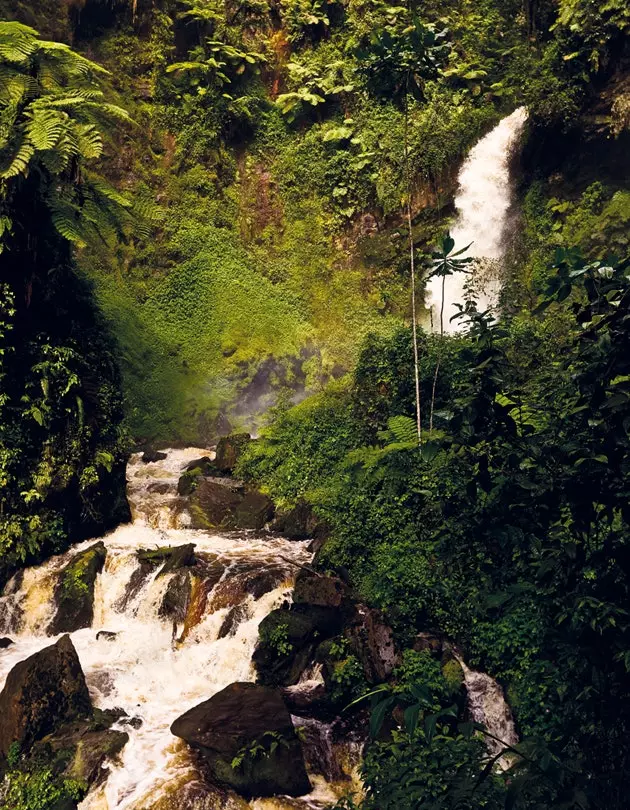
Gorilla family in the Volcanoes National Park
Agashya will soon be 30 years old. He has shiny black hair, almost bluish, strong and powerful arms, and a well-deserved reputation as a gallant. His distinguished demeanor and that look of his own who has a lot to tell reminds us of Gregory Peck in Moby Dick. Nobody knows very well where he came from, maybe from the other side of the Sabyngo volcano, from the Congo or from Uganda. But the truth is that one fine day, he was nine years ago now, he began to be seen on this side of the jungle forests of Virunga, north of Rwanda, hovering around what is known as Group 13 by the rangers of the Volcanoes National Park.
With his imposing silver sash, it didn't take him long to show that the youngster who was acting the role of alpha male was too big for him. Too much responsibility not to have changed the hair on his back yet. Nor did he convince the harem of females that he was the one to protect them, lead them to the tastiest fruits along paths free of traps and, of course, to seduce them.
In just three years, 10 babies were born. Agashya and his family are one of the 786 mountain gorillas that live on the planet, all of them sheltered in the dense vegetation of the tropical forests that cover the mountainous heart of Africa. This number that seems so alarmingly low is, all things considered, good news. Thirty years ago, at the time Dian Nyiramacibili Fossey, 'the woman who lives alone in the forest', dedicated her life to studying many of these same gorillas in the mist, only 250 individuals remained.
It is easy to understand the fascination aroused by these gigantic apes, the largest of all, a symbol of positive force – the chimpanzee, perhaps because of his carnivorous tendencies, was associated with diabolical power. Only 2.3 percent of our nuclear genetic material and barely nine million years of evolution separate us from them. Sharing an hour of your time with them (only 56 per day, at $500 each) and looking into their eyes is the sole objective of most of the more than 20,000 visitors who travel to Rwanda annually, many in a of the classic safari through Kenya or Tanzania. Almost none stay more than three days. Unfortunately, they are depriving themselves of the possibility of discovering a truly unusual country and taking, along the way, a good lesson in self-improvement and respect for nature. It is the other image of Africa.
The first thing was that unmistakable tropical smell. And then the surprise: it's not hot at all! We meet in Kigali, just on the line of Ecuador, but at 1,600 meters of altitude, so high that malaria does not reach here, in the capital of a tiny country, similar in size to Belgium, lost in the mountains. The country of a thousand hills, say the tourist brochures, the tibet of africa . I'm glad I left the jacket handy.
Outside the airport (eye, plastic bags are as persecuted as the gorilla meat trade), the astonishment continues in the streets. A woman is struggling to sweep a sidewalk where you could eat without a plate. No crowds, no loud music, no smell of food, no cigarette butt lying on the ground. Cars, not too many, motorcycles, almost all taxis, and many bikes, happily move through the harmonious chaos. Are you sure we're in Africa? “Yesterday, the last Saturday of the month, was community cleanup day,” our good friend Jean-Luc Mira, Rwanda sales director for the Mantis Collection hotel portfolio, clarifies as we drive through the city. “Everyone, including the president, leaves our tasks for a few hours to work on the maintenance of the country. Doesn't that sound like a 'rwanderful' idea to you?"
As if it were a purge, a purification therapy, this is one of the most visible activities of the reconciliation program designed by the government to promote forgiveness and heal a people that only 16 years ago bled to death as victims of a genocide that wiped out an eighth of the population and today seems to look to Singapore as a model of development and civility. "After the genocide, society was divided, you didn't know who you lived next to," argues Fidele Ndayisaba, mayor of Kigali, “and through community work we get to know our neighbors, and we take responsibility for building our city”. Of course today's Kigali does not correspond to the stereotyped idea of African cities. Skyscrapers are beginning to rise toward the clouds, and the hillsides of humble homes are being replaced by better-built villas to cater to a growing middle class.

Agashya the gorilla
The feeling is that money flows, moves, generates prosperity. “ There is work here, education is good, there is no malaria, nor is it hot, and I am not afraid that my wife will be walking down the street alone at twelve at night” , says Joshua Poveda, the chef from Madrid, on the terrace of his Heaven restaurant, the best in the city. The person responsible for the change is Paul Kagame, in his second and, according to him, last term of seven years. His influential circle of friends includes Tony Blair, Eric Schmidt (CEO of Google), Howard Schultz (CEO of Starbucks)...
Everyone is happy about the existence of an oasis of peace, of a financial and technological center as God intended in the unstable heart of Africa. Kagame's slender figure, however, could not be more controversial. In his homeland he is a national hero, the brave savior who stopped the 1994 slaughter while Western countries turned a deaf ear to calls for help. Outside the borders, that same international community accuses him of applying an eye for an eye to the Hutus refugees in the Congo where, according to the investigations that the UN is carrying out in the area, between one and five million Hutus were killed between 1996 and 2002. Kagame hides behind reconciliation and declares that in his country they no longer speak of Hutus and Tutsis, but of Rwandans. In Africa, wars take place without witnesses, in secret, without the rest of the world even caring.
It is true that the Hutus come from Central Africa and the Tutsis from East Africa, from the plains of Sudan, but contrary to popular belief, Hutus and Tutsis share language, culture and religious beliefs, and the only visible differences are the What does it mean to be a poor farmer (the Hutus, 85% of the population) or a rich owner of herds of cows (the Tutsis, 14%)? They are not different tribes or ethnic groups, but the two main social classes of a historically feudal society. The aristocracy and the vassals. If you prospered in life you became a Tutsi, if you lost your herd you became a Hutu.
Although in Rwanda the conflicts took forms of social revolution, the dispute has always been over land that is scarce in a mountainous country. That is what happened in 1959 and in 1962, 1964, 1973, 1992...and, worst of all, in the spring of 1994. On April 7, 1994, the plane carrying the former Rwandan president, Habyarimana, a Hutu radical who had been in power for 21 years, was shot down before landing at the Kigali airport, and the RTLM radio station, in the hands of the Hutu militias, encouraged whoever wanted to listen to “clean the country of those Tutsi cockroaches ”. What followed was one of the biggest genocides in history: 800,000 Tutsis hacked to death in three months. Walking through the rooms of the Kigali Memorial Center, opened in 2004 to try to explain the inexplicable, I wonder how it is possible to continue living after so much pain. Would I be able to forgive the one who killed my mother, my brothers, my children? Where was I in the spring of 1994? And you?
“After all, in Rwanda things also work the E.E.A way.” E.E.A.? "This is Africa". It's true, I'm an impatient westerner, I smile as I give another try to akarusho, a kind of local beer that the waiter served me as wine. It's purple, smells like cheap table wine, and tastes like sweet liquor. It is not too bad. We have been waiting for an hour for the classic veal skewers, a house specialty and 'national dish'. We deceive the stomach with a snack of sambazas, tasty local fish. The lights on the Kigali hills shimmer in the distance like the smiles of our table neighbors.
At night, the Republika Lounge of the elegant Solange Katabere is the trendy restaurant among the Rwandan middle class. Another example of local success is Bourbon Coffee. With four locations in the best areas of Kigali and three in the US (New York, Washington D.C. and Boston), Bourbon Coffee has not only made a million-dollar contract with Starbucks, but is changing the habits of the population. “ We are one of the main coffee producers, but in Rwanda the people who can drink milk. If not, beer, or tea, but almost never coffee” , explains the director of marketing. The export of coffee is, together with that of tea, the main source of income in this country where, despite dreams of prosperity, three out of four inhabitants live by working the fields, generally for others.
Gorillas also do not drink water. They prefer to extract it from the wood of trees. And so we found them that morning, peeling the eucalyptus forest as if it were palulús. The mist lifts in the valleys as the jeep stumbles along the muddy roads, giving us the traditional Rwandan massage. “Hello, hello muzungu (white man)!” shouts the children as we pass by. “Bite, bite!” There are people who walk four or five hours through the jungle until they find a family of gorillas. Others just an hour. Us, barely fifteen minutes for a field of potatoes.
Upon reaching the stone barrier that protects the crop from the buffalo, a severed trunk reveals that an elephant has passed through here. "It had disappeared, but they are coming back," says the guide. We walk in silence through a bamboo forest. The gorillas are already close, according to the trackers, probably a little drunk from the fermentation of the bamboo.
A ball of black fur appears running through the reeds. It's a little gorilla! He is not alone, here comes his mom. To my right, another female uproots a bush right at my feet. I want to think that she is playing. The silverback enters the scene taking our breath away. He is huge! It must be more than two meters. Agashya's roars fill the forest. Will our presence bother you? Passing by us, less than five meters away, he looks at us as if we were transparent and poses cheekily for the photo. He seems to be aware that serving visitors at breakfast time is the job that pays the rent for the jungle.

Panoramic view of the Nyungwe region
25 years ago, venturing into Nyungwe Forest was an expedition worthy of the Victorian era . Now it takes less than two hours to travel by car. Next to the road, near where a Chinese engineer directs the work of conditioning the asphalt, a sign indicates the direction of the channels of the two longest rivers on the continent. Next to it, a yellow box indicates that there is Wi-Fi here. Just from this point the Congo River flows to the west and the Nile to the northeast. In 2005 it was discovered that the sought-after sources of the Nile, the furthest from its mouth, are here, in the Rukarara River, adding 106.2 km more to its course. Thus, the greatest geographical mystery since the discovery of America was revealed. And it is not the only enigma that Nyungwe hides.
Before us, high but at the same time soft mountains unfold to infinity. There are no obvious threats on the landscape. Everything is harmonious and cordial. And the greenest green you can imagine. It is an emerald anchored in time. Nyungwe Rainforest was this lush and green when the rest of the planet was covered in ice. Legend has it that its beauty was already so overwhelming, so perfect, that the gods decided to respect it and keep it intact while the world changed.
This Ice Age survivor is one of the few remaining remnants of the primary forest that covered the entire Albertine Rift. A fundamental element for climate regulation, it represents the 70% of Rwanda's freshwater reserves and is home to 275 species of birds , to 240 types of trees, 140 kinds of orchids and 13 species of primates, including the friendly colobus, a black and white monkey that I find very similar to James Brown, and our cousins the chimpanzees.
King Muvunyi was proud of his kingdom . He had more than he could ever want. But one day, when he woke up, he discovered that someone had released his herd of cows, which were wandering lost in the forest. What if he never saw him again? What if the neighboring king kept it? Desperate, he sent a thousand of his peasants to find the culprit, promising them riches and blessings. None of them slept until the matter was resolved: the culprit, a four-year-old boy, wanted to prove to himself that he could be as good a shepherd as his father. The king was so amused that he decided to give each of them a hill. And from then on, Rwanda became "the kingdom of a thousand hills". This was the story I found on my pillow that first night at the Nyungwe Forest Lodge. I dreamed that I could fly and that my mission was to count, one by one, the mountains of Rwanda. I got more than a thousand.
“I don't know if you've noticed, but almost 70 percent of what decorates the hotel is local,” says Jerry, the hotel's manager, a friendly Kenyan whose sweet voice invites long conversations in front of the fireplace. Ceiling lamps made with tea strainers, ceramic walls imitating the designs of ancient kings, baskets in which to carry offerings... The Nyungwe Forest Lodge, owned by Dubai and managed by South Africa, It is the most impressive hotel in the country and one of the three lodges in the park. "We need foreign investors," confesses Kambogo, who is in charge of tourism in the national park. “In 2010 we received 6,000 visitors, but this year we expect at least 15,000. Since we opened the canopy walk last October, visits, especially from local tourists, have doubled."
Apart from the opening of the suspension bridge that brings you closer to the treetops, the park is expanding its network of trails and diversifying its offer for all audiences. "Soon we will open a camp near the chimpanzees, another one for bird watching and we will organize airplane flights." Each bird has at least three different calls and songs. Of fear, anger, interest... Knowing them, and even more so being able to imitate them, is the secret of birdwatching.
Narcisse Ndayambaje can have a conversation, just about anything, with some 180 of the 275 bird species that live in Nyungwe, including the flashy prickly pears. “On one occasion, with an English tourist, we managed to see all but two of the endemic species (there are 24). It was on the Rukuzi and Karamba trails”, she tells me with sincere humility. "Although the hard part, really, is photographing them." Her smile suddenly turns into an order. "Schhhssss." On the branch of a towering Umushishi (Symphonia globulifera), two Cinnamon-chested Bee-eaters seem to have hit it off. “Look, there, gray and red with a black head. It's a Black headed waxbill." It's tiny. “And, come on, a White tailed blue flycatcher. He has a beautiful tail." Where?? His pupils run through every branch, every bush. His ears don't move, but I'm sure his ears do.

Waterfall in the Nyungwe Rainforest
We are at the end of the rainy season and the flowers color a landscape that runs the gamut of greens. I think of the number of diseases that can be cured with these plants, snake bites included. “This one for example”, she says, tearing off a leaf that looks like any other, “Crassocephalum vitellium. Stops bleeding immediately. And male sterility! And the giant lobelia is the best for sore spots." A movement in the branches of a Carapa grandiflora, too abrupt to be a bird, makes us look up. It's a blue jumpsuit, no, two. And we've only gone 20 meters down the path behind the tea factory..
To visit the chimpanzees you have to get up early. And a lot. But getting up at four in the morning has the reward of seeing the sunrise, something that in Africa is usually synonymous with 'wow' and 'wow'. The chimpanzees, oblivious to such beauty and displaying British punctuality, had already left to find more breakfast elsewhere. . From branch to vine, these agile apes are capable of moving at great speed through the jungle. It is estimated that they spend a third of their time on trees. For us humans, advancing on the jungle floor, and more quickly, and uphill, is not so easy. The clay soil makes us skid. And the fear of accidentally grabbing a snake or gouging out my eye with the thorns of an acacia leaves me little chance to be entranced by the magic hidden in the trunks of the trees.
Perched on one of them, two male chimpanzees observe us with distant curiosity. They are Kibibi and Nyiraneza. They have been distracted from the group to roam freely for a while. The way they move and look at each other, so human, awakens an immediate sympathy in me. . They say that chimpanzees are capable of feeling the emotions of others. I don't doubt it, in fact they are, together with the bonobos, our closest relatives. Only the upright posture, sexual habits and the size of the brain differentiate us. And a ridiculous 1.6 percent of our DNA. What will they think of us?
Sitting on the porch of the Nyungwe Forest Lodge, I enjoy my last African tea while I watch the mist make the forest disappear. Thunder threaten storm. I feel that the mist is like a protective cushion, a filter that only reveals shadows of true life, and The last words written by Dian Fossey in his diary come to mind: “When you understand how much life, all life, is worth, the past matters less to you and you focus more on protecting the future.”
This report was published in issue 42 of Traveler magazine
